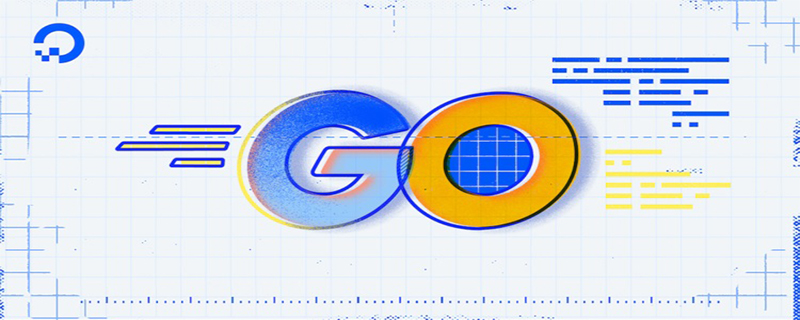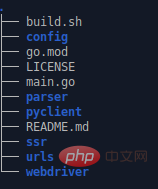Introduction to using go get for package management in go modules

Package management under module
First we introduced go mod edit to modify go.mod, but it has Two flaws:
1. First, its -require must accept the form of "package@version", which is indispensable, and it cannot recognize the master and latest flags specified in the document.
2. Secondly, edit is only suitable for modifying dependency versions, renaming packages, and blocking specific packages. It is not suitable for adding dependencies.
The good news is that go get now has the ability to add/modify/update packages in modules.
To fully experience go modules, we need to select a directory other than GOPATH and set GO11MODULE=on. In this way, using go get will only affect the current main module and will not pollute GOPATH.
We clone the project to a non-GOPATH path, and then use
go mod init [project name]
to initialize the module. Initialized directory:

At this time go.mod is still empty. We know that go build will update go.mod, so we go build first

By default, go get will be used to obtain the latest package. Now go.mod has been updated and the project has been successfully compiled. This is the meaning of go.mod:
module schanclient
require (
github.com/PuerkitoBio/goquery v1.4.1
github.com/andybalholm/cascadia v1.0.0 // indirect
github.com/chromedp/chromedp v0.1.2
golang.org/x/net v0.0.0-20180826012351-8a410e7b638d // indirect
)indirect It means that this package is dependent on the sub-module/package, but the main module is not directly imported and used, which is the so-called indirect reference.
Usually, go.mod can complete package management well using the default behavior, but there are always some exceptions in life.
We see that chromedp uses version 0.1.2, which is the version three months ago. The latest commit was last month. Go mod edit needs to clearly specify the version number or commit time checksum. Obviously This is cumbersome and not what we want.
So how can we use the latest version instead of the latest tags?
Or maybe we don’t want the latest version and need a specific version of the package?
This is the content of version selection.
New features of go get - version selection
There used to be a solution like gopkg.in go get, but the new go The version selection supported by get is a further expansion of this solution. Look at a few rules:
go get will automatically download and install the package, and then update it to go.mod
can be used go get package[@version] to install the specified version of the package. When version is not specified, the default behavior is the same as go get package@latest
version can be in the form of vx.y.z or directly use the commit checksum, or It can be master or latest
When version is latest, it is the default behavior. For packages with tags, the latest tag will be selected. For packages without tags, the latest commit
## will be selected. #When version is master, regardless of whether the package is tagged, the latest commit of the master branch will be selected. You can use >, >=, <, <= before version to indicate the selected version. It must not exceed/below the version. The versions within this range that meet the latest conditionsgo get -u can update the package to the latest versiongo get -u=patch will only update the minor version , for example, from v1.2.4 to v1.2.5When you want to modify the package version, you only need to go get package@specified versionThen we want to use chromedp instead The latest version is very simple:go get github.com/chromedp/chromedp@master
module schanclient require ( github.com/PuerkitoBio/goquery v1.4.1 github.com/andybalholm/cascadia v1.0.0 // indirect github.com/chromedp/chromedp v0.1.3-0.20180717231922-bf52fed0d3e6 golang.org/x/net v0.0.0-20180826012351-8a410e7b638d // indirect )
go get github.com/jinzhu/gorm
module schanclient require ( github.com/PuerkitoBio/goquery v1.4.1 github.com/andybalholm/cascadia v1.0.0 // indirect github.com/chromedp/chromedp v0.1.3-0.20180717231922-bf52fed0d3e6 github.com/jinzhu/gorm v1.9.1 // indirect github.com/jinzhu/inflection v0.0.0-20180308033659-04140366298a // indirect golang.org/x/net v0.0.0-20180826012351-8a410e7b638d // indirect )
go get github.com/jinzhu/gorm@v1.9
The above is the detailed content of Introduction to using go get for package management in go modules. For more information, please follow other related articles on the PHP Chinese website!

Hot AI Tools

Undresser.AI Undress
AI-powered app for creating realistic nude photos

AI Clothes Remover
Online AI tool for removing clothes from photos.

Undress AI Tool
Undress images for free

Clothoff.io
AI clothes remover

AI Hentai Generator
Generate AI Hentai for free.

Hot Article

Hot Tools

Notepad++7.3.1
Easy-to-use and free code editor

SublimeText3 Chinese version
Chinese version, very easy to use

Zend Studio 13.0.1
Powerful PHP integrated development environment

Dreamweaver CS6
Visual web development tools

SublimeText3 Mac version
God-level code editing software (SublimeText3)

Hot Topics
 1381
1381
 52
52
 In-depth understanding of Golang function life cycle and variable scope
Apr 19, 2024 am 11:42 AM
In-depth understanding of Golang function life cycle and variable scope
Apr 19, 2024 am 11:42 AM
In Go, the function life cycle includes definition, loading, linking, initialization, calling and returning; variable scope is divided into function level and block level. Variables within a function are visible internally, while variables within a block are only visible within the block.
 How to match timestamps using regular expressions in Go?
Jun 02, 2024 am 09:00 AM
How to match timestamps using regular expressions in Go?
Jun 02, 2024 am 09:00 AM
In Go, you can use regular expressions to match timestamps: compile a regular expression string, such as the one used to match ISO8601 timestamps: ^\d{4}-\d{2}-\d{2}T \d{2}:\d{2}:\d{2}(\.\d+)?(Z|[+-][0-9]{2}:[0-9]{2})$ . Use the regexp.MatchString function to check if a string matches a regular expression.
 How to send Go WebSocket messages?
Jun 03, 2024 pm 04:53 PM
How to send Go WebSocket messages?
Jun 03, 2024 pm 04:53 PM
In Go, WebSocket messages can be sent using the gorilla/websocket package. Specific steps: Establish a WebSocket connection. Send a text message: Call WriteMessage(websocket.TextMessage,[]byte("Message")). Send a binary message: call WriteMessage(websocket.BinaryMessage,[]byte{1,2,3}).
 The difference between Golang and Go language
May 31, 2024 pm 08:10 PM
The difference between Golang and Go language
May 31, 2024 pm 08:10 PM
Go and the Go language are different entities with different characteristics. Go (also known as Golang) is known for its concurrency, fast compilation speed, memory management, and cross-platform advantages. Disadvantages of the Go language include a less rich ecosystem than other languages, a stricter syntax, and a lack of dynamic typing.
 How to avoid memory leaks in Golang technical performance optimization?
Jun 04, 2024 pm 12:27 PM
How to avoid memory leaks in Golang technical performance optimization?
Jun 04, 2024 pm 12:27 PM
Memory leaks can cause Go program memory to continuously increase by: closing resources that are no longer in use, such as files, network connections, and database connections. Use weak references to prevent memory leaks and target objects for garbage collection when they are no longer strongly referenced. Using go coroutine, the coroutine stack memory will be automatically released when exiting to avoid memory leaks.
 How to view Golang function documentation in the IDE?
Apr 18, 2024 pm 03:06 PM
How to view Golang function documentation in the IDE?
Apr 18, 2024 pm 03:06 PM
View Go function documentation using the IDE: Hover the cursor over the function name. Press the hotkey (GoLand: Ctrl+Q; VSCode: After installing GoExtensionPack, F1 and select "Go:ShowDocumentation").
 A guide to unit testing Go concurrent functions
May 03, 2024 am 10:54 AM
A guide to unit testing Go concurrent functions
May 03, 2024 am 10:54 AM
Unit testing concurrent functions is critical as this helps ensure their correct behavior in a concurrent environment. Fundamental principles such as mutual exclusion, synchronization, and isolation must be considered when testing concurrent functions. Concurrent functions can be unit tested by simulating, testing race conditions, and verifying results.
 How to use Golang's error wrapper?
Jun 03, 2024 pm 04:08 PM
How to use Golang's error wrapper?
Jun 03, 2024 pm 04:08 PM
In Golang, error wrappers allow you to create new errors by appending contextual information to the original error. This can be used to unify the types of errors thrown by different libraries or components, simplifying debugging and error handling. The steps are as follows: Use the errors.Wrap function to wrap the original errors into new errors. The new error contains contextual information from the original error. Use fmt.Printf to output wrapped errors, providing more context and actionability. When handling different types of errors, use the errors.Wrap function to unify the error types.




